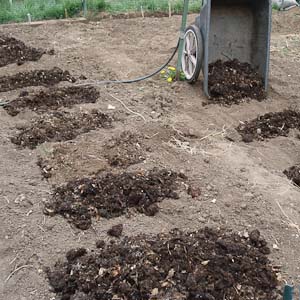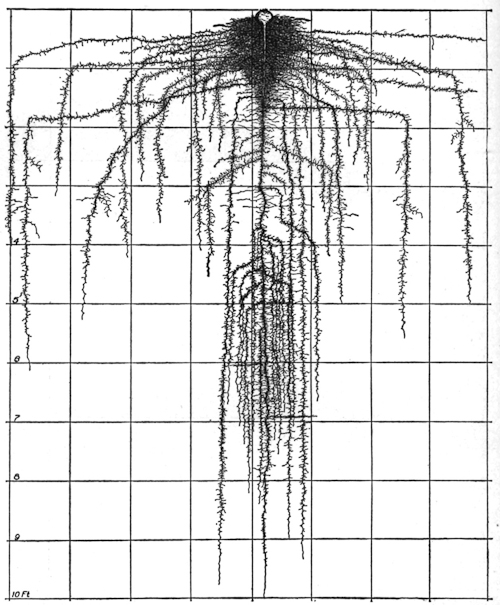- Home
- No-Till Gardening
No-Till Gardening
 Compost Will Be Scratched In
Compost Will Be Scratched InShallowly in This No-Till Garden
No-till gardening is an idea whose time has come. But it's not as simple as just stopping tilling without changing anything else about the way we garden. No-till gardening is one tool in an integrated program of ecological vegetable gardening in which we build up our soil ecology to the point where the totality of the soil life does the "tilling" for us!
Combined with re-mineralizing, mulching, compost, boosting soil microbial life, cover-cropping and refraining from ever walking on growing beds, no-till gardening can, over time, cut your spring workload in half.
There are two sections below, the "Why" and the "How-to". If you want to skip straight to the "How-to" section click here. I encourage you to read all the way through, however, because understanding the "Why" gives meaning to the "How-to".
Why Tilling Hurts Soil
Tilling destroys soil life.
When we till deeply, we completely destroy the soil ecosystem that nature designed to sustain plant life. Tilling shreds fungal networks, kills earthworms and destroys their tunnels, and destroys beneficial bacterial biofilms, all of which work together to recycle nutrients.
Nature’s system was sustainable indefinitely - a closed recycling system for the stuff that bodies are built from - until we started hauling produce, livestock, manure away from the land that produced it, and not returning wastes and bodies to the soil.
Now I’m not saying we should start using
our poops in the garden or bury Granddad out back! We obviously can’t
do that, but this means we need to figure out how we’re going to replace
the minerals we’ve been taking away, because our food is becoming less
and less nutritious, and salt-based chemical fertilizers are killing the soil ecosystem.
Gardening with nature means helping the
organisms in the soil that do nature’s recycling, so they can do
their important job of feeding the plants that feed us. This means no
more tilling or use of harsh chemical fertilizers (yes, "Miracle Gro" et al) that kill soil life
and only replace a few of the minerals that are taken away.
Tilling creates a “hardpan”.
A few inches below the depth that the tiller can reach, a layer of densely compacted soil forms in response to tilling. The weight of the person plus the weight of the tiller compacts the soil just below the tiller tines (or plow blade, shovel, etc.)
Plant roots have a difficult time penetrating this hardpan layer, which slows growth and limits nutrient uptake dramatically. Plant roots will hit the hardpan layer and then grow sideways and stay shallow, which makes the plants more susceptible to drought, less able to gather nutrients and require more space in the vegetable garden.
Tilling destroys soil structure.
Good soil has a structure, created by microbes and plant root exudates, that holds together in a way that helps provide plants with appropriate levels of water, air and nutrient availability. It sounds counterintuitive, but when soil is pulverized by tilling, capillary action doesn’t work effectively to distribute water.
When soil is pulverized to what looks to us like nice loose fluffy stuff, the tiny air channels that are created by biofilms, roots, earthworms and fungi are destroyed, and nutrients are released which then wash down into the subsoil where they become unreachable or add to the density of the hardpan.
Tilling mixes soil layers.
In nature, each layer of soil serves a distinct function, and each has its own unique bacteria and other soil life. Tilling mixes layers and destroys the ecologically-balanced system that nature designed to optimally support plant life.
Tilling releases carbon into the atmosphere.
It’s been discovered that humus in the soil used to be a huge bank of sequestered carbon. Large-scale modern agriculture (as well as tilling our own gardens) creates conditions that allow this carbon to oxidize away into the atmosphere. Science is now pointing to modern agricultural practices as a major contributor (perhaps the major contributor) to elevated carbon dioxide levels in the atmosphere.
Tilling favors weeds.
Tilling does two things that encourage weeds: it brings fresh weed seeds up to the surface (which were buried deep by prior tilling), and creates conditions where they can thrive.
Since nature is quite ingenious, she tries to “heal” soil that has been damaged by using plants that thrive in harsh soil conditions. We call them “weeds”, which are usually very deep-rooted plants that are able to pull water and nutrients up from deep subsoil. Given enough time, weeds will actually refresh soils that have been damaged by tilling.
Tilling makes plants more chemically dependent.
When soil life is destroyed by tilling, a plant’s “digestive” and “immune” systems are destroyed along with it. Plants can then no longer get the minerals they need, and because of this, they become weaker and more vulnerable to pests and diseases.
We then compensate by
feeding them artificial fertilizers and dousing them with pesticides to
keep them from being consumed. To make matters worse, both the artificial fertilizers and the pesticides directly kill soil life, turning the plants into "addicts" that are now dependent on the use of chemicals to give them the minimum they need to survive. (This is the current state of commercial agriculture.)
Switching to No-Till Gardening: The "How-To"
No-Till Gardening As Part of An Integrated Program
Beyond the question of “to till or not to till” lies a deeper question. In order to restore our soils to vibrant health we must rethink the entire way we have been growing food. For no-till gardening to work it needs to be part of an integrated program that must also include:
- replacing the missing mineral nutrition in the soil, and continued attention to it over time
- nurturing the life in the soil, so that those billions of tiny critters can do their job of recycling and collecting minerals and feeding them to the plants.
- stopping tilling (or double digging) deeper than 1-2”
- keeping the soil covered at all times, either with growing vegetables, mulch, or a cover crop
- keeping the soil moist, never letting it dry out so much that it stresses plants or kills microbes
- never walking on or compacting the growing beds
Remineralizing the Soil
This is the biggest step, and to do it properly is beyond the scope of this article. See the Soil Sample and Organic Fertilizer
pages to learn how to figure out what your soil needs and how to supply
it. Before we abruptly stop digging in our no-till, regenerative
garden, we do need to get the initial “dose” of appropriate minerals
mixed into the top 6” of soil. Again, the Organic Fertilizer article will
show you how to do that.
Do not believe the many misinformed voices on the web who tell you that enough mulch or compost on the soil surface will supply all the minerals your garden needs “the way nature does it in a forest”.
This is false for three reasons:
- nutrient-dense vegetables are much more “hungry” for minerals than forest or grassland plants
- a natural forest or prairie does not get harvested and removed year after year, taking minerals away
- mulch, compost and manure no longer contain sufficient minerals because they themselves are now grown on mineral-deficient soil. (All crops now contain a fraction of the minerals they did in our grandparent's day.)
Restoring the Soil Life
Most of our soils are suffering from a severe insufficiency of soil microbes, killed off by tilling, artificial fertilizers, herbicides and pesticides. Soil microbes serve as an external digestive system for plants -- the mechanism that provides the mineral nutrition they need to survive and be healthy. Just like we need to have healthy gut bacteria in order to digest our food (and have strong immunity), so plants need to have healthy “gut” bacteria in the soil. Once we stop tilling and killing, we can feed our soils a type of “probiotic” to restore these missing microbes. This is also beyond the scope of this article, but you can learn how to do it on the Actively Aerated Compost Tea page.
Most soil life lives in the top six or eight inches of soil. Beneficial bacteria, archea, fungi, actinomycetes, earthworms and other organisms each have a part to play in soil nutrient cycling. Their job includes gathering minerals from a large area, converting them into forms that plants can use, and transporting them into the plant. In return, the plant trades them sugars that it makes via photosynthesis and exudes out its roots. In a healthy soil/plant ecosystem there are thousands of specific symbiotic relationships that trade specific substances.
Stopping Tilling
In a no-till system, narrow single rows are generally replaced by wider growing beds, which are never walked on or compacted in any way. This gives plants more area to spread their roots through uncompacted soil. After an initial digging-in of minerals and inoculation with actively-aerated compost tea, the growing beds are usually mulched with a layer of straw, rotted or shredded leaves, pulled-up weeds or high-quality compost. I say “usually”, because if you live in a wet area where slugs are a problem, you may have to forego the mulch.
Decide how wide to make your
growing beds and your paths. I like my growing beds to be about 42”
wide, because at 5’2” tall, if they’re any wider than that I can’t reach
into the middle. Make your beds twice your reach, so that you can
access the middle from the path on either side. To remain loose, friable
and porous, you must never compact the soil in any way, so never walk
on it or step on it.
Mulching
In case you don't really know what "mulch" is, it is a layer of organic matter (usually, though sometimes people use plastic for specific purposes) placed on the surface of the soil, which also feeds the soil life as it breaks down and turns into compost.
Mulching accomplishes several things: it covers the soil and prevents the sun from burning up the microbes on the surface, helps reduce evaporation, reduces weed seed germination, keeps the soil cooler or warmer (depending on which end of the season you're talking about) and feeds earthworms, fungi, good bacteria, other microbes and lots of other soil critters.
It can also harbor slugs and slug eggs.
(This article is still under construction, check back soon for remaining details, which will include Mulching and Cover-Cropping.)
Help share the skills and spread the joy
of organic, nutrient-dense vegetable gardening, and please...
~ Like us on Facebook ~
Thank you... and have fun in your garden!
Affiliate Disclaimer
This website contains affiliate links to a few quality products I can genuinely recommend. I am here to serve you, not to sell you, and I do not write reviews for income or recommend anything I would not use myself. If you make a purchase using an affiliate link here, I may earn a commission but this will not affect your price. My participation in these programs allows me to earn money that helps support this site. If you have comments, questions or concerns about the affiliate or advertising programs, please Contact Me.Contact Us Page




